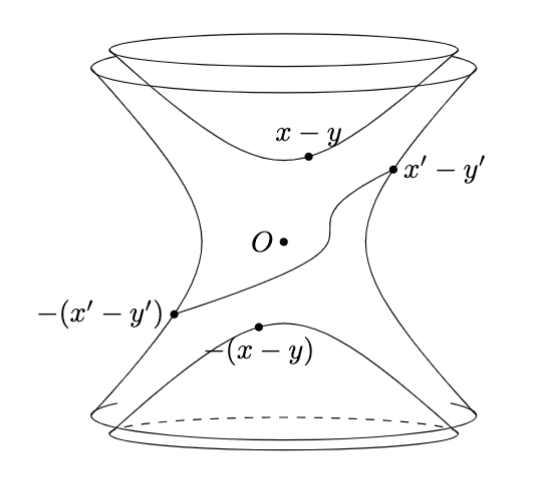
【Read between lines】Peskin, Shcroeder "An Introduction to Quantum Field Theory" pp. 28-29 (Continuous Lorentz transformation for spacelike x-y to y-x)
Key words
Lorentz transformation
spacelike
light cone
Relevant section
When $${(x-y)^2<0}$$, we can perform a Lorentz transformation on the second term (since each term is it separately Lorentz invariant), taking $${(x -y)\to-(x-y)}$$, as shown in Fig. 2.4. The two terms are therefore equal and cancel to give zero; causality is preserved. Note that if $${(x-y)^2>0}$$ there is no continuous Lorentz transformation that takes $${(x-y)\to-(x-y)}$$.
Solution
Fig. 2.4 on the textbook shows the light cone and hyperboloid. Since Lorentz transformation is continuous, there have to be a continuous path connecting two points on the hyperboloid, if you get one point by transformation from the other.

As the figure shows, a hyperboloid out of the light cone is connected, otherwise one in the cone is separated into two parts. Therefore there is no connected path between timelike symmetric points, i.e., no continuous transformation between $${(x-y)\to-(x-y)}$$.
Why hyperboloid
Let us consider the shape of the surface on which a transformed point moves. We cannot draw 4-dim space, so we use $${z=0}$$ subspace. When we transform $${x^\mu=(x^0, x^1, x^2, x^3)\mapsto x'=(\gamma x^0-\gamma\beta x^1, \gamma x^1-\gamma\beta x^0, x^2, x^3)}$$, this transformation is represented as the following eqs.
$$
\begin{array}{ll}x'^0=x^0\cosh\theta-x^1\sinh\theta\\x'^1=x^1\cosh\theta-x^0\sinh\theta\\\beta=\tanh\theta\end{array}
$$
We get,
$$
\begin{array}{rcl}(x^{02}-x^{12})\cosh\theta&=&x^0x'^0-x^1x'^1\\(x^{02}-x^{12})\sinh\theta&=&x^0x'^1-x^1x'^0\\\therefore\quad(x^{02}-x^{12})^2&=&(x^0x'^0-x^1x'^1)^2-(x^0x'^1-x^1x'^0)^2\\&=&(x^{02}-x^{12})(x'^{02}-x'^{12}).\end{array}
$$
This $${x'}$$ represents a hyperbola that passes $${x}$$. If we perform Lorentz transformation only in space, the transformation is only continuous rotation of space; the surface on which Lorentz transformed point moves is a hyperboloid.
この記事が気に入ったらサポートをしてみませんか?
